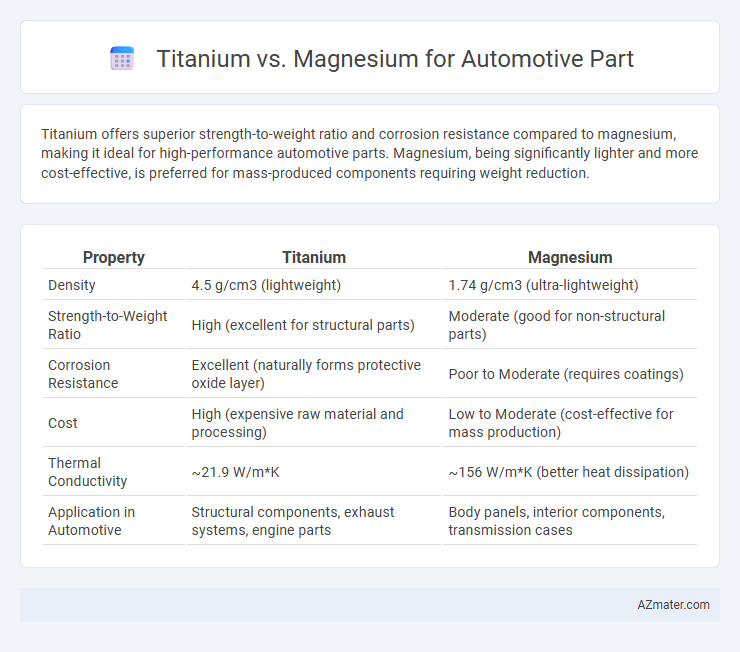Titanium offers superior strength-to-weight ratio and corrosion resistance compared to magnesium, making it ideal for high-performance automotive parts. Magnesium, being significantly lighter and more cost-effective, is preferred for mass-produced components requiring weight reduction.
Table of Comparison
| Property | Titanium | Magnesium |
|---|---|---|
| Density | 4.5 g/cm3 (lightweight) | 1.74 g/cm3 (ultra-lightweight) |
| Strength-to-Weight Ratio | High (excellent for structural parts) | Moderate (good for non-structural parts) |
| Corrosion Resistance | Excellent (naturally forms protective oxide layer) | Poor to Moderate (requires coatings) |
| Cost | High (expensive raw material and processing) | Low to Moderate (cost-effective for mass production) |
| Thermal Conductivity | ~21.9 W/m*K | ~156 W/m*K (better heat dissipation) |
| Application in Automotive | Structural components, exhaust systems, engine parts | Body panels, interior components, transmission cases |
Introduction: The Importance of Material Selection in Automotive Parts
Material selection in automotive parts directly influences vehicle performance, safety, and fuel efficiency, with titanium and magnesium emerging as critical metals due to their unique properties. Titanium offers superior strength-to-weight ratio and corrosion resistance, ideal for high-stress components, while magnesium provides exceptional lightness and good machinability, enhancing overall vehicle weight reduction. Choosing between titanium and magnesium requires balancing factors such as mechanical performance, cost, and manufacturing complexity to optimize automotive design and sustainability.
Overview of Titanium and Magnesium: Properties and Applications
Titanium offers exceptional strength-to-weight ratio, corrosion resistance, and high-temperature tolerance, making it ideal for critical automotive components such as exhaust systems and engine parts. Magnesium is significantly lighter than titanium and aluminum, providing superior weight reduction benefits for automotive parts like transmission cases and wheels, but it has lower corrosion resistance and strength. Both metals enhance vehicle performance and fuel efficiency through weight savings, with titanium favored for durability and magnesium preferred for cost-effective lightweight designs.
Weight Comparison: Titanium vs Magnesium in Automotive Use
Titanium offers a density of approximately 4.5 g/cm3, making it heavier than magnesium, which has a density around 1.74 g/cm3, making magnesium roughly 60% lighter. This significant weight difference means magnesium components contribute substantially more to overall vehicle weight reduction, improving fuel efficiency and handling. However, titanium's superior strength-to-weight ratio and corrosion resistance often justify its use where durability is critical despite the added mass.
Strength and Durability: Evaluating Performance Under Stress
Titanium offers superior strength-to-weight ratio compared to magnesium, making it ideal for automotive parts subjected to high stress and impact. Its exceptional corrosion resistance and fatigue strength contribute to enhanced durability and longer lifespan in demanding environments. Magnesium, while lighter, exhibits lower tensile strength and is more prone to corrosion, resulting in reduced performance under prolonged mechanical stress.
Corrosion Resistance: How Titanium and Magnesium Withstand the Elements
Titanium exhibits exceptional corrosion resistance due to its stable oxide layer, making it highly effective against rust and harsh environmental conditions in automotive parts. Magnesium, while lightweight and strong, requires protective coatings to improve its susceptibility to oxidation and corrosion over time. The inherent durability of titanium ensures longer lifespan and less maintenance compared to magnesium when exposed to moisture, salt, and chemicals.
Cost Analysis: Economic Implications for Automakers
Titanium offers superior strength-to-weight ratio and corrosion resistance but comes with significantly higher raw material and processing costs compared to magnesium. Magnesium is more cost-effective due to abundant availability and easier manufacturing processes, enabling lower overall production expenses for automotive parts. Automakers must balance the high initial investment of titanium with its long-term durability benefits versus magnesium's affordability and lightweight advantages to optimize cost-efficiency in vehicle design.
Machinability and Fabrication: Manufacturing Considerations
Titanium offers excellent corrosion resistance and strength-to-weight ratio but presents challenges in machinability due to its high strength and low thermal conductivity, requiring specialized cutting tools and slower processing speeds. Magnesium excels in machinability with easy cutting and shaping, making it cost-effective for high-volume automotive parts; however, it demands careful handling due to its flammability and lower corrosion resistance compared to titanium. Manufacturing considerations include balancing machining efficiency and tool wear for titanium with safety precautions and surface treatments for magnesium to ensure durability and performance in automotive applications.
Sustainability and Environmental Impact
Titanium offers exceptional corrosion resistance and durability, making it a sustainable choice for automotive parts by extending component lifespan and reducing replacement frequency. Magnesium, while lighter and energy-efficient in manufacturing, poses challenges due to its higher reactivity and potential environmental hazards during extraction and recycling processes. Selecting between titanium and magnesium in automotive applications requires balancing weight savings with lifecycle environmental impacts and recyclability metrics.
Popular Automotive Parts Made from Titanium and Magnesium
Titanium is widely used for high-performance automotive parts such as connecting rods, valves, and exhaust systems due to its exceptional strength-to-weight ratio and corrosion resistance. Magnesium is popular in manufacturing lightweight components including engine blocks, transmission cases, and interior trim parts, contributing to overall vehicle weight reduction and improved fuel efficiency. Both metals enhance automotive performance by balancing durability and weight savings in critical areas.
Conclusion: Choosing the Right Material for Automotive Applications
Titanium outperforms magnesium in automotive applications due to its superior strength-to-weight ratio, corrosion resistance, and high-temperature stability, making it ideal for structural components. Magnesium offers advantages in cost and ease of casting but falls short in durability and impact resistance. Selecting the right material depends on whether the priority is lightweight performance with long-term reliability or cost-effective manufacturing with moderate strength.

Infographic: Titanium vs Magnesium for Automotive Part
 azmater.com
azmater.com